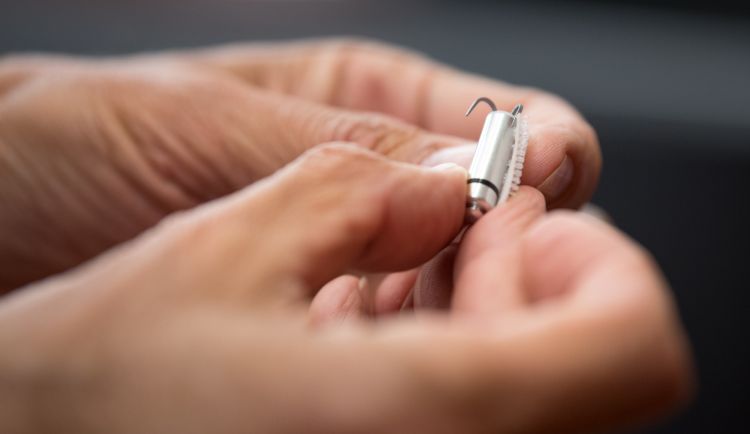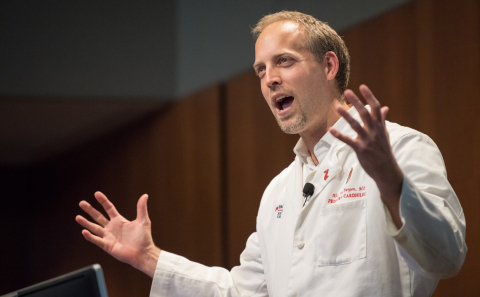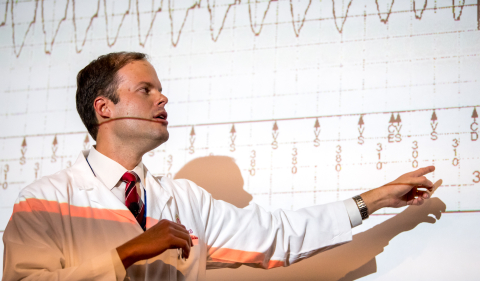A matter of timing: Atrial fibrillation and arrhythmias

Photo caption: above, an attendee of a Mini Med School lecture on cardiac arrhythmias holds a next-generation, leadless transcatheter pacemaker that is approximately the size of a nickel coin.
Two lecture halls at the Health Sciences Learning Center were filled to capacity for the September 28, 2017 Mini Med School session on Atrial Fibrillation and Arrhythmias.
This public event was led by Richard Page, MD, George R. and Elaine Love Professor and chair, Department of Medicine, and Laurel Rice, MD, Ben Miller Peckham, MD, PhD, Distinguished Professor and Chair, Department of Obstetrics and Gynecology. An attentive audience listened to lectures by Lee Eckhardt, MD, MS, associate professor, Michael Field, MD, associate professor (CHS), and Miguel Leal, MD, assistant professor (CHS), all of Cardiovascular Medicine; and Nicholas Von Bergen, MD, associate professor (CHS), Department of Pediatrics.
Dr. Page began by reminiscing about the experience that led to his own passion for understanding heart rhythm problems: witnessing a teenaged girl with Wolff-Parkinson-White syndrome travel from the Midwest to Duke University for surgery while he was a medical student. "I saw her in clinic one day, and then the next day I watched her cardiologist hold her beating heart and tell the surgeon where to perform cardioablation," he said. At the time, this was an open chest procedure requiring a week in the hospital. Today, the procedure is done with a one-day hospital stay and a catheter.
From room-sized electrocardiograms to custom-engineered cardiomyocytes
 To illustrate how far the field has come, Dr. Page introduced Dr. Lee Eckhardt. A physician-scientist, Dr. Echkardt is one of exceedingly few electrophysiologists in the nation who also manages an NIH-funded laboratory.
To illustrate how far the field has come, Dr. Page introduced Dr. Lee Eckhardt. A physician-scientist, Dr. Echkardt is one of exceedingly few electrophysiologists in the nation who also manages an NIH-funded laboratory.
"Your heart is an electrically driven pump. It pumps 60 to 80 times per minute, 100,000 beats per day, 25 million times a year, and 3 billions times per life span," said Dr. Eckhardt. She explained how electrical signals are proliferated throughout heart tissue by a cascade of events inside each cell in which calcium ions are released by the sarcoplasmic reticulum and binding of these calcium ions generates each heartbeat.
The first practical electrocardiogram (abbreviated interchangeably as ECG and EKG) was invented by Dutch physician Willem Einthoven. The instrument occupied an entire room. Dr. Eintoven was awarded the 1924 Nobel Prize in Medicine for his work, and although modern ECGs are small enough to be wearable consumer devices, all owe a debt to the original version.
Dr. Eckhardt's particular research interest is sudden cardiac death syndrome. In some cases, sudden cardiac death occurs when a fatal arrhythmia - ventricular tachycardia - is caused by heart attack scarring that creates a "short circuit" within the heart. A less common cause of sudden cardiac death is inherited conditions in individuals who have mutations in genes involved in generating electrical signals in the heart.
Dr. Eckhardt explained how colleagues including Timothy Kamp, MD PhD, professor, Cardiovascular Medicine and co-director of the UW–Madison Stem Cell and Regenerative Medicine Center, have developed methods for growing induced pluripotent stem cells (iPSCs) such that a patient's blood can be used to generate new cardiomyocytes. In some instances, iPSC-derived cardiomyocytes can be used to test potential drugs. If a drug candidate affects the synchronized, beating rhythms of cultured cells in a desirable manner, physicians can be more confident that the drug will be safe and effective in patients.
Treating arrhythmias in the very youngest patients
 Dr. Nicholas Von Bergen described some of his most difficult cases as a pediatric electrophysiologist - such as patients he has cared for while they were still in the womb. For example, he has used fetal magnetocardiography to monitor arrhythmias caused by atrial flutter, and showed an ultrasound of a fetus whose body was shutting down due to a heart rate exceeding 200 beats per minute.
Dr. Nicholas Von Bergen described some of his most difficult cases as a pediatric electrophysiologist - such as patients he has cared for while they were still in the womb. For example, he has used fetal magnetocardiography to monitor arrhythmias caused by atrial flutter, and showed an ultrasound of a fetus whose body was shutting down due to a heart rate exceeding 200 beats per minute.
"But most of my patients are out of the womb," he reassured the audience. In many instances, they might have supraventricular tachycardia (SVT), a condition affecting one in a thousand people.
Dr. Von Bergen is also an expert on treating Wolff-Parkinson-White (WPW) syndrome, a congenital condition in which an extra electrical pathway between the heart's upper and lower chambers causes a rapid heartbeat. While in some cases the syndrome can be harmless, in others it can be life-threating.
"I don't want to treat the ECG. I want to treat the patient," said Dr. Von Bergen, explaining that depending on the situation a patient may simply be monitored, treated with long-term medication affecting heart rhythm, or treated with catheter-based ablation.
The other end of the spectrum: treating older adults with atrial fibrillation
 "About three million people in the United States are thought to have atrial fibrillation or AFib, and that number will increase as the population ages," said Dr. Michael Field. "About one in ten people who live to the age of 80 will have Afib."
"About three million people in the United States are thought to have atrial fibrillation or AFib, and that number will increase as the population ages," said Dr. Michael Field. "About one in ten people who live to the age of 80 will have Afib."
In this condition, Dr. Field explained, the upper chambers of the heart can "quiver" and send erratic signals, causing fast and erratic heartbeats. "I've had patients describe it as a chest sensation of rumbling thunder, pounding drums, or even a flopping fish," said Dr. Field.
Controlling the heart rate is a primary goal, and can often be accomplished with medications. Importantly, he explained, Afib can increase the risk of stroke, so reducing this risk is important; for this reason, people living with Afib are often prescribed blood thinners. Often the course of disease is improved by managing underlying risk factors such as obesity, hyptertension, diabetes, alcohol, and sleep apnea.
More recently, a medical device has begun to be used to prevent clots from being released from the left atrial appendage. This device has only been approved for patients who are not good candidates for long-term use of blood thinning medications, though. Finally, catheter-based ablation procedures can be used to treat Afib when drugs fail to mitigate the arrhythmia.
Life-saving technologies: pacemakers, defibrillators, and more
 The final speaker of the evening was Dr. Migual Leal, who specializes in device-based therapies for cardiac arrhythmias.
The final speaker of the evening was Dr. Migual Leal, who specializes in device-based therapies for cardiac arrhythmias.
"Sudden cardiac arrest is the largest killer in the United States and most of the world," said Dr. Leal. On average, only 9 percent of people who experience sudden cardiac arrest outside of a hospital setting will survive it. "You'd have to add deaths from all forms of cancer together to exceed the annual mortality rate of sudden cardiac arrest."
For this reason, he explained the placement of automated electronic defibrillators (AEDs) has been a critical public health issue - one that Dr. Page has championed and researched. Easily-accessed AEDs aboard commercial airplanes have resulted in survival rates of in-flight sudden cardiac arrest of around 50 percent.
"But for some patients at high risk, implantable cardioverter-defibrillators allow you to have your own personal paramedic inside your body. It does nothing except watch your heart rhythm, and one day if needed, it will shock or pace your heart," said Dr. Leal.
While implantable defibrillators can be expensive, Dr. Leal showed economic analyses indicating that the cost per life-year saved of about $66,000 is in line with many other common public safety measures such as flashing lights and barriers at railroad crossings.
But defibrillators are not without risks. One of the biggest problems can be lead wires for the device that end up becoming integrated into the heart tissue itself, such that surgical extraction of the lead when the device needs to be replaced can be dangerous. Newer subcutaneous defibrillator models do not have leads at all, and one leadless pacemaker has been approved earlier this year that is the size of a quarter.
"In the future, we'll start to see allied technologies such as a subcutaneous defibrillator and a pacemaker disc in the heart, and they'll talk to each other using bluetooth."
At this thought, audience members shook their heads in amazement. The future is fast approaching, asserted Dr. Leal; in fact, it's already here. "There are three patients right now on the planet - one in India, one in Cleveland, and one in South Africa - that have such a system in their bodies. Within a year, we'll be implanting these devices into patients at UW."
Resources:
- "New cardiac medical devices offer options," Department of Medicine, March 9, 2017
- Heart rhythm disorders - UW Health